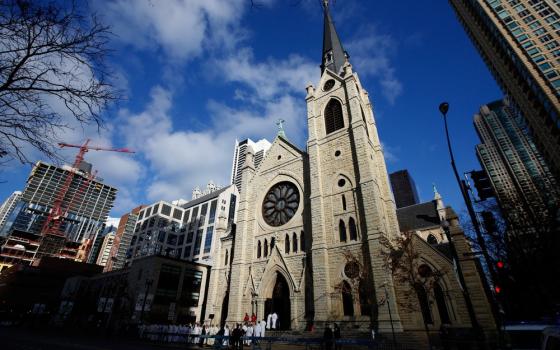A comparison of the synoptic Gospels with the Gospel of John reveals obvious differences, one of which concerns the miracles or wonders worked by Jesus. Generally, the synoptics represented most of Jesus' miracles as acts of power by which Jesus established the reign of God and defeated the reign of Satan. Some miracles, like the multiplication of the loaves for the many, have symbolic significance. These echo themes from the Hebrew Scriptures and are represented as the fulfillment of prophecies; they also point ahead to future events -- for example, the Eucharist.

| Fifth Sunday of Lent |
| Ezekiel 7:12-14 Psalm 130 Romans 8:8-11 John 11:1-45 |
But, in the fourth Gospel, the evangelist has chosen to pass on to his readers only seven events that have come to be known as signs. Through each sign, something of the person and purpose of Jesus is revealed, and those who witness the sign are challenged to come to believe in him. As Raymond E. Brown has explained, the signs in John could be compared to the prophets' symbolic actions in the Hebrew Scriptures (The Gospel According to John, Doubleday, 1996). Often, the prophet performed an action that portrayed God's coming judgment or future intervention (as in Jeremaiah 13:1-11; Isaiah 20:3; Ezekial 12:1-16). However, in the realized eschatology of the Johannine Gospel, the signs of Jesus not only prophesy about God's intervention but already contain it. Each sign is to be understood as testimony to the presence of God in Jesus.
In the seventh and greatest sign of the fourth Gospel, Jesus called Lazarus forth from his grave. Jesus accomplished what Ezekiel had promised in the prophecy that constitutes today's first reading: "I will open your graves and have you rise from them ... then you shall know that I am the Lord!" In so doing, Jesus was revealed as one sent by God, as one with God, and as the resurrection and the life.
When asked if she believed this, Martha responded, "Yes, Lord!" and professed her faith in Jesus, "the Christ, the Son of God." But her faith was still growing, as was that of the disciples, who, from the first sign at Cana to the seventh sign at Bethany, were deepening their knowledge of Jesus. Full, salvific faith, as Brown has pointed out, "is a gift of God which, like the gift of the Spirit, can come only after the resurrection."
As the sacred texts are proclaimed yet again in our hearing, we are to become aware that Lazarus' story and his experience are a paradigm for every believer. Just as Jesus loved Lazarus (John 11:3, 36), so does Jesus love us. Similarly, just as Jesus wept for Lazarus (John 11:35), so is Jesus fully and even emotionally invested in our well-being. Moreover, just as Lazarus was raised, so every believer begins to live life anew at baptism and, after death, rises to live forever in glory with the Lord.
Roland Faley reminds us that the preface in the Mass of Christian Burial declares that in death "life is changed, not taken away" (Footprints on the Mountain, Paulist Press, 1994). Death is a passage or a transition, not a terminal experience. This does not mean there is no pain or sorrow or wrenching separation at death. But if we truly accept Jesus at his word, and if we truly understand Lazarus' story as the story of us all, then there will arise in us hope and trust that will see us through that passage with strength and assurance.
Until such time as God calls us home, Paul (second reading) reminds us that we are to live life in accordance with the Spirit of God who dwells within. A dynamic, uncontainable entity, the Spirit is constantly urging us toward goodness, justice, righteousness, peace and compassion for others. As our teacher, defender, guide and inspiration, the Spirit is not content to be heeded only once in a while or when it is convenient. On the contrary, the Spirit compels us to be the growth and transformation we want to experience in our world. Henri Nouwen believed that if people were more attentive to the Spirit, it would affect everything they touched (Eternal Seasons, edited by Michael Ford, Ave Maria Press, 2007). Not only would it have an impact on personal growth and relationships, but it would also influence economics, politics and all social structure. Did Jesus have such transformation in mind when he bequeathed his Spirit to his own? Surely he did. We who profess to believe in him as the resurrection and the life are endowed by his Spirit to be living signs that reveal who Jesus is and challenge others to share our faith in him.
[Patricia Sánchez holds a master's degree in literature and religion of the Bible from a joint degree program at Columbia University and Union Theological Seminary in New York.]




